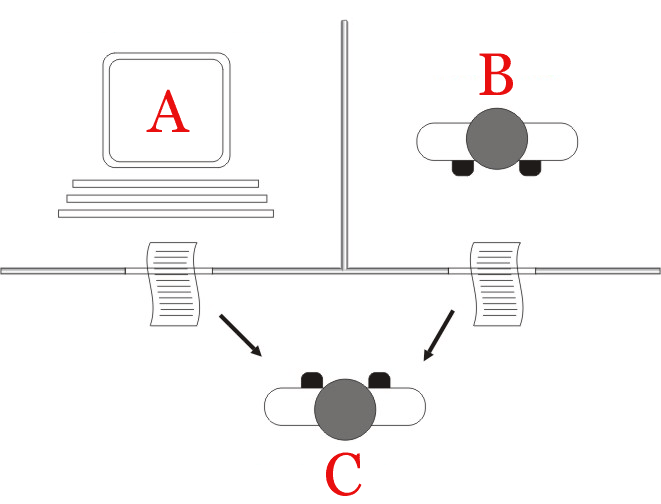|
Chatterbot
A chatbot or chatterbot is a software application used to conduct an on-line chat conversation via text or text-to-speech, in lieu of providing direct contact with a live human agent. Designed to convincingly simulate the way a human would behave as a conversational partner, chatbot systems typically require continuous tuning and testing, and many in production remain unable to adequately converse, while none of them can pass the standard Turing test. The term "ChatterBot" was originally coined by Michael Mauldin (creator of the first Verbot) in 1994 to describe these conversational programs. Chatbots are used in dialog systems for various purposes including customer service, request routing, or information gathering. While some chatbot applications use extensive word-classification processes, natural-language processors, and sophisticated AI, others simply scan for general keywords and generate responses using common phrases obtained from an associated library or database. ... [...More Info...] [...Related Items...] OR: [Wikipedia] [Google] [Baidu] |
Verbot
The Verbot (Verbal-Robot) was a popular chatterbot program and Artificial Intelligence Software Development Kit (SDK) for Windows and the web. Early beginning virtual personalities, Inc. traces its technology back to Michael Mauldin's work as a graduate student and post-doctoral fellow at Carnegie Mellon University; and its artistry back to Peter Plantec's work in personality psychology and art direction. Historic outline In 1994, Mauldin, Founder of Lycos, Inc., developed a prototype Chatterbot, Julia, which competed in the internationally known Turing test, for the coveted Loebner Prize. The Turing Test matches computer scientist judges against machines to see if they can distinguish a computer from a real human. This prototype version was refined and developed, and in 1997, Dr. Mauldin and Peter Plantec, a clinical psychologist, and animator, formed Virtual Personalities, Inc. (now Conversive, Inc.) in order to create a virtual human interface that would incorporate real ... [...More Info...] [...Related Items...] OR: [Wikipedia] [Google] [Baidu] |
ELIZA Conversation
ELIZA is an early natural language processing computer program created from 1964 to 1966 at the MIT Artificial Intelligence Laboratory by Joseph Weizenbaum. Created to demonstrate the superficiality of communication between humans and machines, Eliza simulated conversation by using a "pattern matching" and substitution methodology that gave users an illusion of understanding on the part of the program, but had no built in framework for contextualizing events. Directives on how to interact were provided by "scripts", written originally in MAD-Slip, which allowed ELIZA to process user inputs and engage in discourse following the rules and directions of the script. The most famous script, DOCTOR, simulated a Rogerian psychotherapist (in particular, Carl Rogers, who was well known for simply parroting back at patients what they had just said), and used rules, dictated in the script, to respond with non-directional questions to user inputs. As such, ELIZA was one of the first chatter ... [...More Info...] [...Related Items...] OR: [Wikipedia] [Google] [Baidu] |
Turing Test
The Turing test, originally called the imitation game by Alan Turing in 1950, is a test of a machine's ability to artificial intelligence, exhibit intelligent behaviour equivalent to, or indistinguishable from, that of a human. Turing proposed that a human evaluator would judge natural language conversations between a human and a machine designed to generate human-like responses. The evaluator would be aware that one of the two partners in conversation was a machine, and all participants would be separated from one another. The conversation would be limited to a text-only channel, such as a computer keyboard and screen, so the result would not depend on the machine's ability to render words as speech. If the evaluator could not reliably tell the machine from the human, the machine would be said to have passed the test. The test results would not depend on the machine's ability to give correct question answering, answers to questions, only on how closely its answers resembled t ... [...More Info...] [...Related Items...] OR: [Wikipedia] [Google] [Baidu] |
Natural Language Processing
Natural language processing (NLP) is an interdisciplinary subfield of linguistics, computer science, and artificial intelligence concerned with the interactions between computers and human language, in particular how to program computers to process and analyze large amounts of natural language data. The goal is a computer capable of "understanding" the contents of documents, including the contextual nuances of the language within them. The technology can then accurately extract information and insights contained in the documents as well as categorize and organize the documents themselves. Challenges in natural language processing frequently involve speech recognition, natural-language understanding, and natural-language generation. History Natural language processing has its roots in the 1950s. Already in 1950, Alan Turing published an article titled "Computing Machinery and Intelligence" which proposed what is now called the Turing test as a criterion of intelligence, t ... [...More Info...] [...Related Items...] OR: [Wikipedia] [Google] [Baidu] |
ELIZA
ELIZA is an early natural language processing computer program created from 1964 to 1966 at the MIT Artificial Intelligence Laboratory by Joseph Weizenbaum. Created to demonstrate the superficiality of communication between humans and machines, Eliza simulated conversation by using a "pattern matching" and substitution methodology that gave users an illusion of understanding on the part of the program, but had no built in framework for contextualizing events. Directives on how to interact were provided by "scripts", written originally in MAD-Slip, which allowed ELIZA to process user inputs and engage in discourse following the rules and directions of the script. The most famous script, DOCTOR, simulated a Rogerian psychotherapist (in particular, Carl Rogers, who was well known for simply parroting back at patients what they had just said), and used rules, dictated in the script, to respond with non-directional questions to user inputs. As such, ELIZA was one of the first chatterb ... [...More Info...] [...Related Items...] OR: [Wikipedia] [Google] [Baidu] |
Jabberwacky
Jabberwacky is a chatterbot created by British programmer Rollo Carpenter. Its stated aim is to "simulate natural human chat in an interesting, entertaining and humorous manner". It is an early attempt at creating an artificial intelligence through human interaction. Purpose The stated purpose of the project is to create an artificial intelligence that is capable of passing the Turing Test. It is designed to mimic human interaction and to carry out conversations with users. It is not designed to carry out any other functions. Unlike more traditional AI programs, the learning technology is intended as a form of entertainment rather than being used for computer support systems or corporate representation. Recent developments do allow a more scripted, controlled approach to sit atop the general conversational AI, aiming to bring together the best of both approaches, and usage in the fields of sales and marketing is underway. The ultimate intention is that the program move from ... [...More Info...] [...Related Items...] OR: [Wikipedia] [Google] [Baidu] |
Artificial Linguistic Internet Computer Entity
A.L.I.C.E. (Artificial Linguistic Internet Computer Entity), also referred to as Alicebot, or simply Alice, is a natural language processing chatterbot—a program that engages in a conversation with a human by applying some heuristical pattern matching rules to the human's input. It was inspired by Joseph Weizenbaum's classical ELIZA program. It is one of the strongest programs of its type and has won the Loebner Prize, awarded to accomplished humanoid, talking robots, three times (in 2000,Thompson 2002, pg. 3 2001, and 2004). The program is unable to pass the Turing test, as even the casual user will often expose its mechanistic aspects in short conversations. Alice was originally composed by Richard Wallace; it "came to life" on November 23, 1995. The program was rewritten in Java beginning in 1998. The current incarnation of the Java implementation is Program D. The program uses an XML Schema called AIML (Artificial Intelligence Markup Language) for specifying the heurist ... [...More Info...] [...Related Items...] OR: [Wikipedia] [Google] [Baidu] |
PARRY
PARRY was an early example of a chatbot, implemented in 1972 by psychiatrist Kenneth Colby. History PARRY was written in 1972 by psychiatrist Kenneth Colby, then at Stanford University. While ELIZA was a tongue-in-cheek simulation of a Rogerian therapist, PARRY attempted to simulate a person with paranoid schizophrenia. The program implemented a crude model of the behavior of a person with paranoid schizophrenia based on concepts, conceptualizations, and beliefs (judgements about conceptualizations: accept, reject, neutral). It also embodied a conversational strategy, and as such was a much more serious and advanced program than ELIZA. It was described as "ELIZA with attitude". PARRY was tested in the early 1970s using a variation of the Turing Test. A group of experienced psychiatrists analysed a combination of real patients and computers running PARRY through teleprinters. Another group of 33 psychiatrists were shown transcripts of the conversations. The two groups were then ... [...More Info...] [...Related Items...] OR: [Wikipedia] [Google] [Baidu] |
News
News is information about current events. This may be provided through many different Media (communication), media: word of mouth, printing, Mail, postal systems, broadcasting, Telecommunications, electronic communication, or through the testimony of Witness, observers and witnesses to events. News is sometimes called "hard news" to differentiate it from soft media. Common topics for news reports include war, government, politics, education, health, the Climate change, environment, economy, business, fashion, entertainment, and sport, as well as Wikipedia:Unusual articles, quirky or unusual events. Government proclamations, concerning Monarchy, royal ceremonies, Law, laws, Tax, taxes, public health, and Crime, criminals, have been dubbed news since ancient times. Technology, Technological and Social change, social developments, often driven by government communication and espionage networks, have increased the speed with which news can spread, as well as influenced its conten ... [...More Info...] [...Related Items...] OR: [Wikipedia] [Google] [Baidu] |
Joseph Weizenbaum
Joseph Weizenbaum (8 January 1923 – 5 March 2008) was a German American computer scientist and a professor at MIT. The Weizenbaum Award is named after him. He is considered one of the fathers of modern artificial intelligence. Life and career Born in Berlin, Germany to Jewish parents, he escaped Nazi Germany in January 1936, immigrating with his family to the United States. He started studying mathematics in 1941 at Wayne State University, in Detroit, Michigan. In 1942, he interrupted his studies to serve in the U.S. Army Air Corps as a meteorologist, having been turned down for cryptology work because of his "enemy alien" status. After the war, in 1946, he returned to Wayne State, obtaining his B.S. in Mathematics in 1948, and his M.S. in 1950. Around 1952, as a research assistant at Wayne, Weizenbaum worked on analog computers and helped create a digital computer. In 1956 he worked for General Electric on ERMA, a computer system that introduced the use of the magnetically ... [...More Info...] [...Related Items...] OR: [Wikipedia] [Google] [Baidu] |
Real-time Computing
Real-time computing (RTC) is the computer science term for hardware and software systems subject to a "real-time constraint", for example from event to system response. Real-time programs must guarantee response within specified time constraints, often referred to as "deadlines". Ben-Ari, Mordechai; "Principles of Concurrent and Distributed Programming", ch. 16, Prentice Hall, 1990, , page 164 Real-time responses are often understood to be in the order of milliseconds, and sometimes microseconds. A system not specified as operating in real time cannot usually ''guarantee'' a response within any timeframe, although ''typical'' or ''expected'' response times may be given. Real-time processing ''fails'' if not completed within a specified deadline relative to an event; deadlines must always be met, regardless of system load. A real-time system has been described as one which "controls an environment by receiving data, processing them, and returning the results sufficiently quic ... [...More Info...] [...Related Items...] OR: [Wikipedia] [Google] [Baidu] |



.jpg)
